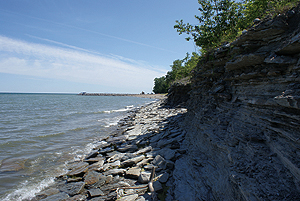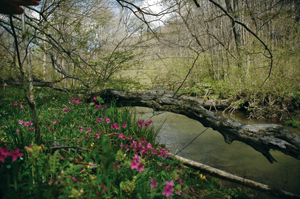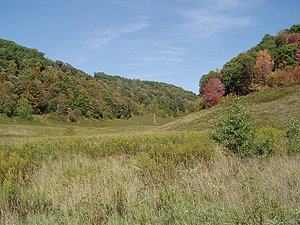WPC’s Land Conservation Efforts Impact Many Regions

Land conservation is a critical component of the Western Pennsylvania Conservancy’s work. Since 1932, the WPC has conserved more than 233,000 acres. In 2012 alone, the program protected 14 parcels totaling 3,112 acres. The work permanently protected forests, stream fronts, farmlands and wetlands, safeguarding habitat for wildlife, helping to protect waterways and expanding opportunities for people to enjoy the outdoors.
WPC’s 2012 land conservation highlights include:
- • The continuing protection of French Creek through the acquisition of a 283-acre Crawford County property along Cussewago Creek. Scientists have recorded a heron rookery and more than 190 species of birds, including bald eagles, marsh wrens and pied-billed grebes, in the area.
- • The conservation of important wildlife habitats, including 55 acres in Venango County to provide habitat for the eastern massasauga rattlesnake (Sistrurus catenatus catenatus), a state-endangered species.
- • The connection of protected properties through the acquisition of 977 acres of forestland in Fayette County. This parcel connects Forbes State Forest and the Fort Necessity National Battlefield.
- • The preservation of landscapes, including a view shed in southern Indiana County. The Conservancy acquired a working forest conservation easement on 900 acres of forestland near the town of Vintondale, Pa. This conservation easement will permanently protect more than two miles of undeveloped forest near Blacklick Creek and the landscape along a popular biking and walking trail.
In other specific examples, the Conservancy added 23 acres to Wolf Creek Narrows Natural Area in 2012. The Slippery Rock Township, Butler County, hiking destination is owned by WPC and is known for its spring wildflowers, including trillium, bluebell and trout lily. The Conservancy’s expansion includes more than 1,100 feet of frontage along Wolf Creek.
Also in 2012, the Conservancy acquired a conservation easement on a 41-acre property next to McConnells Mill State Park and Slippery Rock Gorge. This area features a forest full of wildlife and a tributary to Hells Run, one of the most pristine streams in the state. The parcel also is adjacent to another property protected under a conservation easement with the Conservancy.
WPC’s land conservation work also includes the stewardship of Conservancy-owned properties by reestablishing native plant species, removing invasive species and debris and maintaining trails and waterway access. While WPC has a stewardship staff, it relies on volunteers to help maintain the properties.
The Conservancy is legally responsible for monitoring conservation easements annually. This last year, WPC staff visited each of the 164 properties with WPC conservation easements and held 15 volunteer workdays to help enhance Conservancy-owned properties.
In-House Scientific Research Informs WPC Work
WPC has the privilege of housing the Pennsylvania Natural Heritage Program, which documents and assesses the condition of plant and animal life around the state. This program not only guides WPC’s land- and water-conservation objectives and actions, but also serves as a leading source of information for local governments, municipalities and businesses seeking to make informed decisions about land use.
This year, WPC scientists conducted 550 field surveys, documenting the plant and animal species that populate Pennsylvania’s landscapes. In 2012, the staff completed an update of the Erie County Natural Heritage Inventory. This county is one of the most biodiverse areas in the state, with 860 distinct populations of rare, threatened and endangered species.
WPC botanists also completed a study of rare plants in Pennsylvania in 2012. Over the course of the project, 90 surveys were conducted, which resulted in 75 new and updated rare plant records.
The Conservancy is participating in a 12-state effort to monitor the population of the threatened wood turtle. This year, a long-term monitoring site was established in Centre County for staff and volunteers to study the turtle population over time.

Lake Erie
French Creek and Lake Erie Shoreline
In 2012, the Conservancy protected five parcels totaling more than 480 acres in this region, which is home to endangered and rare species, as well as recreational opportunities. French Creek, a tributary of the Allegheny River, is ecologically significant, and the Lake Erie shoreline is vital to the local economy and the region’s ecosystem.
The parcels included 16 acres of forest, fields and wetlands stretching across Venango and Greene townships in Erie County; frontage on the West Branch of French Creek; and property near a key stretch of the creek that contains riffles, runs and islands. WPC also permanently protected 92 acres in Girard Township, Erie County, that include access to Elk Creek, a high-quality stream recognized for its world-class steelhead fishing. The year’s highlights in this region also include the protection of a more than 283-acre parcel in Hayfield Township, Crawford County, along Cussewago Creek.

Forbes-Ft. Necessity Connector
Laurel Highlands
WPC permanently protected nearly 2,000 acres in the Laurel Highlands in 2012. This region, known for its mountains, valleys, streams and critical farmland, is home to Forbes State Forest, Ohiopyle State Park and Fort Necessity National Battlefield.
The year’s highlights include the acquisition of 977 acres of forestland between the state forest and the national battlefield. The Conservancy also acquired a working forest conservation easement on approximately 900 acres of forestland in southern Indiana County. Through an agricultural easement, WPC protected more than 37 acres of farmland at the headwaters of Tubmill Creek, an important Westmoreland County stream. The recorded easement will keep the property in private hands while permanently restricting future uses.

Bennett Branch
Northern Woods
This region of the state contains some of the largest expanses of forestland in the eastern United States. Since they are situated at the headwaters of the Allegheny and Susquehanna rivers, the forests protect sources of drinking water for millions of people.
The Conservancy acquired 529 acres – including nearly two miles along the Clarion River – near Ridgway in Elk County. This is the last parcel in a section of protected corridor along the north side of the Clarion River west and south of Ridgway.
In 2012, WPC also permanently protected 55 acres in Venango County containing habitat of the eastern massassauga rattlesnake. WPC also acquired two properties totaling about 29 acres near the Bennett Branch of the Sinnemahoning River in Elk County.
